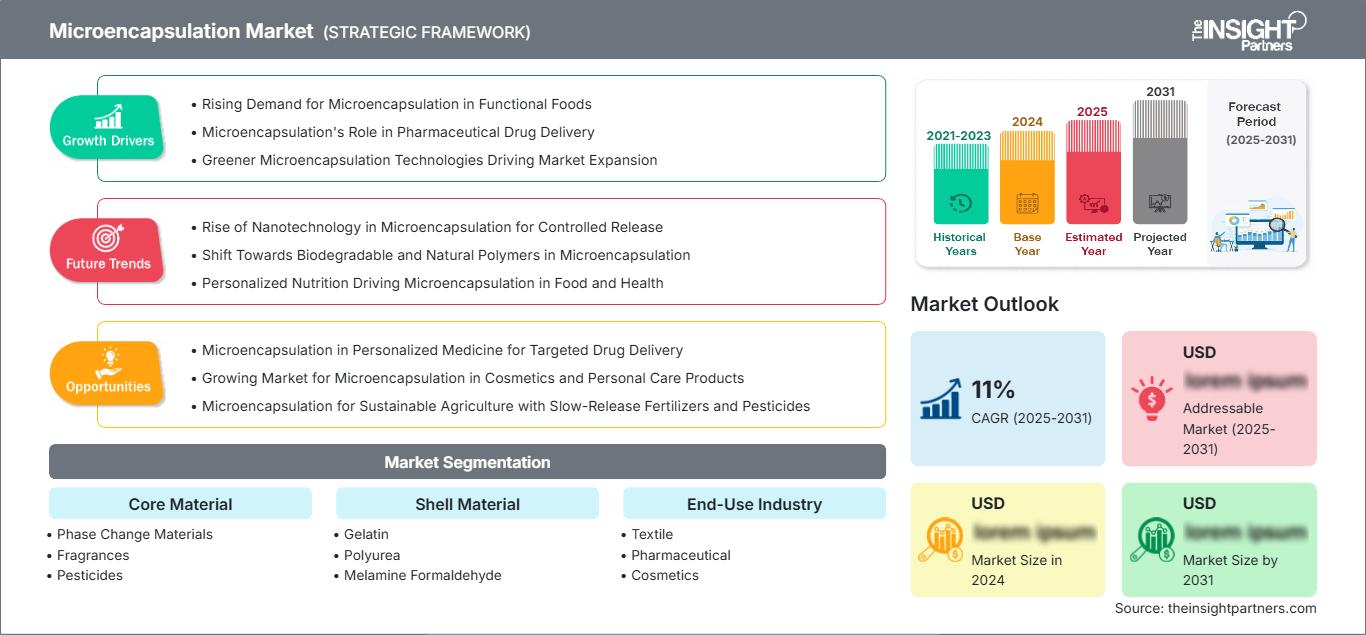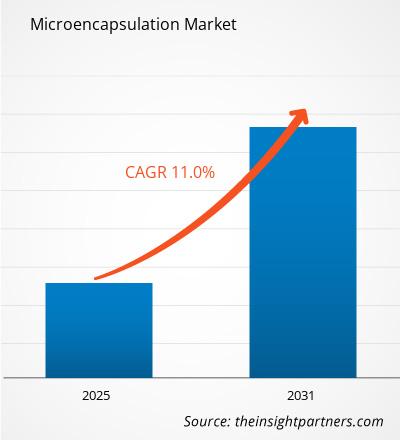Se espera que el tamaño del mercado de microencapsulación alcance los US$ 26.33 mil millones para 2031. Se anticipa que el mercado registre una CAGR del 9,5% durante 2025-2031.
El informe está segmentado por material principal [materiales de cambio de fase (PCM), fragancias, pesticidas, productos farmacéuticos, aditivos alimentarios, otros] y material de cubierta (gelatina, poliurea, melamina formaldehído, polímeros acrílicos, otros). El informe también presenta un análisis basado en la industria de uso final (textil, farmacéutica, cosmética, alimentación y bebidas, agricultura, otros). El análisis global se desglosa a nivel regional y por países principales. Geográficamente, el mercado se divide en América del Norte, Europa, Asia Pacífico, Oriente Medio y África, y América del Sur y Central. El informe ofrece el valor en USD para el análisis y los segmentos mencionados.
Propósito del Informe
El informe "Mercado de Microencapsulación" de The Insight Partners busca describir el panorama actual y el crecimiento futuro, los principales factores impulsores, los desafíos y las oportunidades. Esto proporcionará información a diversas partes interesadas del negocio, como:
- Proveedores/fabricantes de tecnología: Para comprender la dinámica cambiante del mercado y conocer las oportunidades potenciales de crecimiento, lo que les permitirá tomar decisiones estratégicas informadas.
- Inversores: Realizar un análisis exhaustivo de tendencias respecto a la tasa de crecimiento del mercado, las proyecciones financieras del mercado y las oportunidades que existen en toda la cadena de valor.
- Órganos reguladores: Regular las políticas y las actividades policiales en el mercado con el objetivo de minimizar el abuso, preservar la confianza de los inversores y defender la integridad y estabilidad del mercado.
Segmentación del mercado de microencapsulación Material principal
- Materiales de cambio de fase
- Fragancias
- Pesticidas
- productos farmacéuticos
- Aditivos alimentarios
- Otros
Material de la carcasa
- Gelatina
- Poliurea
- Melamina formaldehído
- Polímeros acrílicos
- Otros
Industria de uso final
- Textil
- Farmacéutico
- Productos cosméticos
- Alimentos y bebidas
- Agricultura
- Otros
Geografía
- América del norte
- Europa
- Asia-Pacífico
- América del Sur y Central
- Oriente Medio y África
Obtendrá personalización en cualquier informe, sin cargo, incluidas partes de este informe o análisis a nivel de país, paquete de datos de Excel, así como también grandes ofertas y descuentos para empresas emergentes y universidades.
Mercado de microencapsulación: perspectivas estratégicas

-
Obtenga las principales tendencias clave del mercado de este informe.Esta muestra GRATUITA incluirá análisis de datos, desde tendencias del mercado hasta estimaciones y pronósticos.
Factores que impulsan el crecimiento del mercado de la microencapsulación
- Creciente demanda de microencapsulación en alimentos funcionales: La creciente demanda de microencapsulación se ha visto impulsada por la creciente preferencia de los consumidores por alimentos funcionales con mayor valor nutritivo. Esta innovadora mejora está dirigida a ingredientes sensibles como vitaminas, probióticos y ácidos grasos omega 3, lo que permite su liberación controlada y una mejor biodisponibilidad en los productos alimenticios.
- El papel de la microencapsulación en la administración de fármacos: La microencapsulación influye en gran parte de la industria farmacéutica. Promueve la liberación controlada, actúa como enmascarador del sabor de fármacos desagradables y protege los fármacos de la degradación ambiental. Estas razones explican el rápido desarrollo de las tecnologías de microencapsulación de formulaciones farmacéuticas.
- Tecnologías de microencapsulación más ecológicas impulsan la expansión del mercado: Debido a la creciente presión social para reducir el uso de sustancias nocivas, las industrias están adoptando tecnologías más ecológicas. La técnica de microencapsulación facilita el uso de ingredientes activos, reduciendo así el desperdicio y prolongando la vida útil de los productos. Esto impulsa la transición de las estrategias de producción hacia estrategias más respetuosas con el medio ambiente y económicas, lo que a su vez impulsa la expansión del mercado en muchas industrias.
Tendencias futuras del mercado de microencapsulación
- Auge de la nanotecnología en la microencapsulación para la liberación controlada: El uso de la nanotecnología en la microencapsulación está en auge. Las nanocápsulas permiten la liberación controlada de sustancias activas, estabilizándolas y manteniendo su eficacia. Esto es más común en los sectores farmacéutico y nutracéutico, donde la biodisponibilidad mejorada y la administración dirigida son de suma importancia.
- Cambio hacia polímeros biodegradables y naturales en la microencapsulación: Con el cambio de enfoque hacia la sostenibilidad, existe una creciente tendencia a incorporar polímeros biodegradables y naturales para la microencapsulación. Estos materiales reducen la carga ambiental y ofrecen opciones más saludables en productos alimenticios, cosméticos y sistemas de administración de fármacos, lo que refuerza el comportamiento de compra de los consumidores y organismos reguladores con conciencia ecológica.
- La nutrición personalizada impulsa la microencapsulación en la alimentación y la salud: La nutrición personalizada es una de las nuevas tendencias que está cobrando fuerza en los sectores de la alimentación y la salud. La microencapsulación facilita esta tendencia al permitir la liberación precisa de nutrientes específicos, como vitaminas o suplementos personalizados. Este tipo de tecnología proporciona una mejor absorción y soluciones de salud a medida que impulsan el crecimiento del mercado de la salud y el bienestar personal.
Oportunidades de mercado en microencapsulación
- Microencapsulación en la medicina personalizada para la administración dirigida de fármacos: El uso de la microencapsulación ofrece un gran potencial en la medicina personalizada, especialmente en sistemas de administración de fármacos personalizables, como en la terapia dirigida. A medida que avanzan la genómica y la biotecnología, la microencapsulación puede optimizar la administración terapéutica adaptada al paciente, mejorando el cumplimiento terapéutico, impulsando así el crecimiento del mercado farmacéutico.
- Mercado en crecimiento para la microencapsulación en cosméticos y productos de cuidado personal: El sector cosmético presenta una creciente oportunidad de mercado para la microencapsulación como medio para mejorar la administración de ingredientes activos como vitaminas, antioxidantes y compuestos antienvejecimiento. Esta tecnología mejora la estabilidad, la eficacia y los efectos duraderos en productos para el cuidado de la piel, lo que impulsa nuevos diseños en el mercado de productos de cuidado personal.
- Microencapsulación para la agricultura sostenible con fertilizantes y pesticidas de liberación lenta: La microencapsulación es una propuesta útil en la siembra de fertilizantes y pesticidas de liberación lenta. En la agricultura, los agroquímicos presentan desventajas debido al uso excesivo o la dispersión ambiental inadecuada de los mismos, lo que permite implementar prácticas de limpieza saludables que satisfacen la necesidad actual de conservación ambiental en la agricultura.
Perspectivas regionales del mercado de microencapsulación
Los analistas de The Insight Partners han explicado detalladamente las tendencias regionales y los factores que influyen en el mercado de la microencapsulación durante el período de pronóstico. Esta sección también analiza los segmentos y la geografía del mercado de la microencapsulación en América del Norte, Europa, Asia Pacífico, Oriente Medio y África, y América del Sur y Central.
Alcance del informe de mercado de microencapsulación
| Atributo del informe | Detalles |
|---|---|
| Tamaño del mercado en 2024 | XX mil millones de dólares estadounidenses |
| Tamaño del mercado en 2031 | US$ 26.33 mil millones |
| CAGR global (2025-2031) | 9,5% |
| Datos históricos | 2021-2023 |
| Período de pronóstico | 2025-2031 |
| Segmentos cubiertos |
Por material básico
|
| Regiones y países cubiertos |
América del norte
|
| Líderes del mercado y perfiles de empresas clave |
|
Densidad de actores del mercado de microencapsulación: comprensión de su impacto en la dinámica empresarial
El mercado de la microencapsulación está creciendo rápidamente, impulsado por la creciente demanda del usuario final debido a factores como la evolución de las preferencias de los consumidores, los avances tecnológicos y un mayor conocimiento de los beneficios del producto. A medida que aumenta la demanda, las empresas amplían su oferta, innovan para satisfacer las necesidades de los consumidores y aprovechan las tendencias emergentes, lo que impulsa aún más el crecimiento del mercado.

- Obtenga una descripción general de los principales actores clave del mercado de microencapsulación
Puntos clave de venta
- Cobertura integral: el informe cubre exhaustivamente el análisis de productos, servicios, tipos y usuarios finales del mercado de microencapsulación, proporcionando un panorama holístico.
- Análisis de expertos: el informe se compila con base en el conocimiento profundo de expertos y analistas de la industria.
- Información actualizada: El informe asegura relevancia comercial debido a su cobertura de información reciente y tendencias de datos.
- Opciones de personalización: este informe se puede personalizar para satisfacer los requisitos específicos del cliente y adaptarse adecuadamente a las estrategias comerciales.
Por lo tanto, el informe de investigación sobre el mercado de la microencapsulación puede ayudar a descifrar y comprender el panorama de la industria y sus perspectivas de crecimiento. Si bien existen algunas preocupaciones válidas, las ventajas generales de este informe tienden a superar las desventajas.
- Análisis histórico (2 años), año base, pronóstico (7 años) con CAGR
- Análisis PEST y FODA
- Tamaño del mercado, valor/volumen: global, regional y nacional
- Industria y panorama competitivo
- Conjunto de datos de Excel
Informes recientes
Testimonios
Razón para comprar
- Toma de decisiones informada
- Comprensión de la dinámica del mercado
- Análisis competitivo
- Información sobre clientes
- Pronósticos del mercado
- Mitigación de riesgos
- Planificación estratégica
- Justificación de la inversión
- Identificación de mercados emergentes
- Mejora de las estrategias de marketing
- Impulso de la eficiencia operativa
- Alineación con las tendencias regulatorias






















 Obtenga una muestra gratuita para - Mercado de microencapsulación
Obtenga una muestra gratuita para - Mercado de microencapsulación